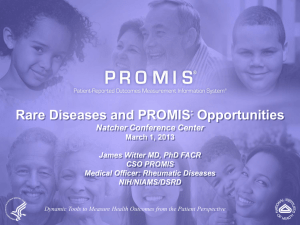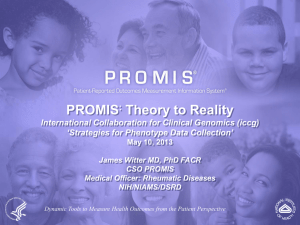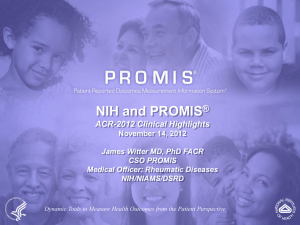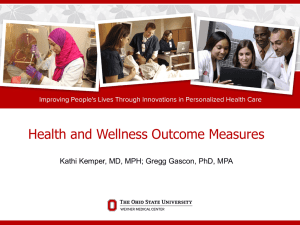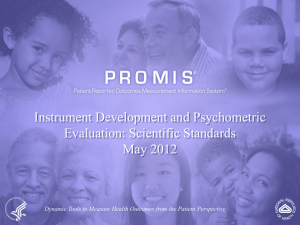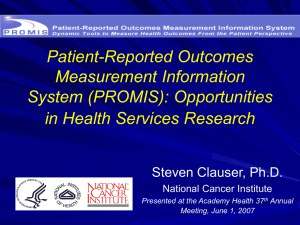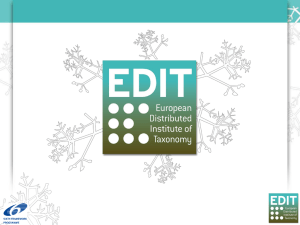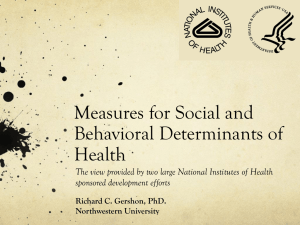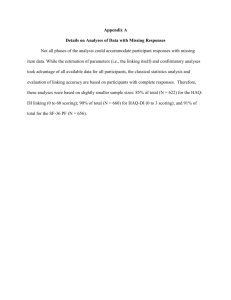genomic methods are
advertisement
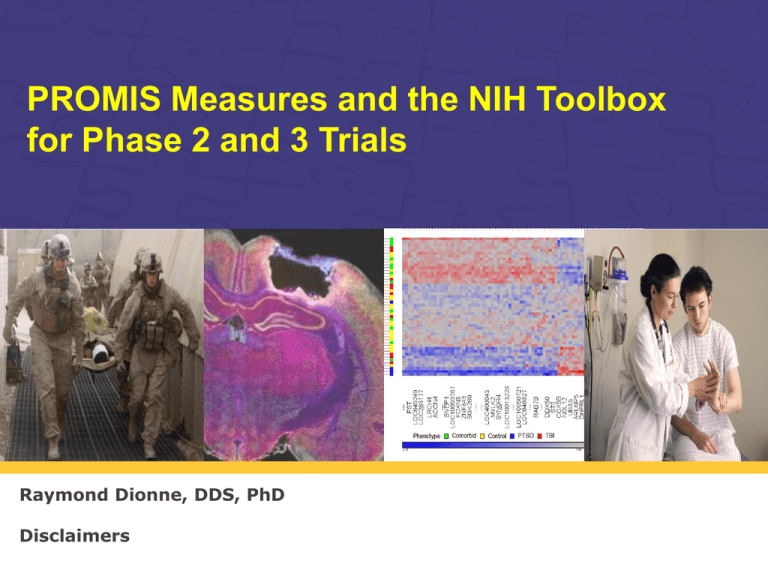
PROMIS Measures and the NIH Toolbox for Phase 2 and 3 Trials Raymond Dionne, DDS, PhD Disclaimers Overview of Analgesic Drug Discovery and Development • Classic approach: basic studies to elucidate analgesic mechanisms, high throughput pharma R&D, clinical studies to evaluate safety and efficacy • Venturing into exploratory methods: genomic methods for unbiased identification of symptoms pathways in humans • Embracing uncertainty: use of genome-wide methods to identify molecular-genetic basis of symptoms in humans • Future Directions: ‘deep phenotyping’ and molecular-genetic dissection of multi-symptom disorders to advance understanding of symptoms biology leading to novel targets for intervention Prerequisite: quantify patient reported outcomes to identify sub-groups for genomic interrogation and provide individualized therapeutics (‘one size does not fit all patients’) Complexity of Pain at the Level of Individual Patients Prior Experience Expectations Mood Sociocultural Environment Idiosyncrasy Genomic Variation Physiology Inflammation CNS Plasticity Genomic Variation Sensory Input Kim & Dionne, Pain/Clinical Updates, 2005 Genomic Variation Visual analogue sc ale (mm ) Wide Variation in Response to Experimental Stimuli Across Individuals 100 Response to Noxious Heat to Skin 80 60 40 20 0 1 100 200 300 400 500 Number of subjects Kim H et al., Pain 2004 Wide Inter-Individual Variation in Responses to Drugs Post-surgical intravenous morphine titration Mean dose for adequate pain relief = 13.3 mg Dose range: 1- 48 mg (0.02 - 0.83 mg/kg) Predicted outcome for a fixed dose across a patient population: • Inadequate pharmacological effect • Adequate efficacy with acceptable side effect liability • Excessive pharmacological effect with adverse drug reactions and less safety ! Alternative – evaluate symptoms biology and therapeutic responses at the patient level patient to ultimately individualize therapy (efficacy, safety) Time to Shift the Paradigm for Analgesic R&D? Large unmet therapeutic need for chronic pain Modest therapeutic innovation in pain over past 50 years Pharmaceutical industry is abandoning drug discovery for neurologic diseases due to poor return on investment Biomarkers considered to be ‘obligatory’ for drug discovery Target validation is best done in humans High variability in pain, analgesic efficacy and safety of analgesic drugs Scientific opportunity knocks: genomic methods are ‘commodities’, PROMIS and NIH Toolbox now available ✓ Time for alternative research strategies using patient reported outcomes and validated biomarkers in humans Evaluating Pathways and Mechanisms of Radiation-Induced Fatigue Piper Fatigue Scale Severe fatigue Moderate fatigue Mild fatigue No fatigue 9 8 7 6 5 4 3 2 1 0 Range Mean Day 0 Day 1 Day 7 Day14 Day 21 Day 42 Day 72 Saligan, Hsiao, Wang et al. Brain Behavior Immunity, 2013 Top 10 Up- and Down-Regulated Genes Top Upregulated Genes Top Downregulated Genes Genes Symbol Gene Name Expression Value Genes Symbol Gene Name Expression Value IFI27 Interferon alpha-inducible protein 27 0.774 MS4A1 B-lymphocyte antigen CD20 -0.821 CA1 Carbonic anhydrase 1 0.705 IGHM Ig mu chain C region -0.816 HBD Hemoglobin subunit delta 0.640 PAX5 Paired box protein Pax-5 -0.791 XK X-linked Kx blood group 0.534 FCRLA Fc receptor-like A -0.669 HBG2 Hemoglobin subunit gamma-2 0.513 TTC3 Tetratricopeptide repeat protein 3 -0.647 RHCE/RHD Blood group Rh(CE) polypeptide 0.507 NSUN5C NOP2/Sun domain family, member 5C -0.642 AHSP Alpha hemoglobin stabilizing protein 0.496 POU2AF1 POU domain class 2-associating factor 1 -0.636 GYPB Glycophorin B 0.483 CCR7 C-C chemokine receptor type 7 -0.632 SNCA Alpha synuclein 0.470 FAIM3 Fas apoptotic inhibitory molecule 3 -0.613 ISCA1 Iron-sulfur cluster assembly 1 homolog 0.464 BLK B lymphoid tyrosine kinase -0.612 Differential Expression of MitochondriaRelated Genes Differentially Expressed Genes High Fatigue vs Low Fatigue (1 yr post EBRT) n = 15 n = 22 Theory of Fatigue Development a-syn (expressed in synapses) IFI27 Lysosomal pathway BCL2 FIS1 SCL25A37 Mitochondrial crisis Vision-Mission: • Vision – The Patient-Reported Outcomes Measurement Information System (PROMIS), funded by the National Institutes of Health, aims to provide clinicians and researchers access to efficient, precise, valid, and responsive adult- andtitle child-reported Click to edit Master style measures of health. • Mission – PROMIS uses measurement science to create an efficient state-of-the-art assessment system for self-reported health. Advancing Patient-Centered Outcomes PROMIS: A Common Source of PROs Click to edit Master title style Clinical Practice Surveys (CDC) Clinical research Clinic Hospital NIH Industry FDA DOMAINS A domain is the specific feeling, function, or perception you want to measure. Click to edit Master title style Cuts across different diseases DOMAINS vs. Diseases • Diseases (common & rare) are combinations of different mechanisms that impact domains • Capturing multiple domains may be optimal way to assess diseases Click to editPRO Master title style • Core-common domains are universally applicable across diseases, ages and ethnicities • Core PRO domains can link common and rare diseases Mechanisms PROs Interleukins Phys Fn Fatigue Social Click to edit Master title style Sleep Chemokines Prostaglandins Anxiety Pain The PROMIS Metric T Score Mean = 50 SD = 10 Click to edit Master title style Referenced to the US General Population PROMIS Fatigue Across Five Clinical Conditions Cancer w/ benefit (2 mos) N = 310 N = 229 Back PainBack Pain Back Pain (3 mos) (1 mo) (B) Depression Depression Depression (1 mo) (3 mos) (B) N = 114 N = 64 Cancer Chemo (B) Click to edit Master title style HF Post-transplant HF Pre-transplant Exacerbation to Stable N = 125 COPD Stable (B) 35 40 45 50 55 Average for General Population COPD Exacerbation (B 60 65 Computerized Adaptive Testing (CAT) Click to edit Integrates IRT with computers to administer a PRO instrument • selects questions on the basis of a patient’s response to previously administered questions • measurement is “adapted” to Masterindividual title style • skips uninformative items to minimize response burden • allows determination of person’s standing on a domain without a loss in measurement precision. Computerized Adaptive Tests Question #1 3 low physical function 1 0 Question #3 2 2 1 -3 -2 -1 0 2 Question #2 1 high physical function Questionnaire with a high precision AND a wide range CAT Starts with an Item Bank • Covers the whole range of the domain • Items are “calibrated” (difficulty and discrimination) Click to edit Master title style PROMIS® Adult Banks: v1.0 Domains Emotional Distress – Anger Emotional Distress – Anxiety Emotional Distress – Depression Fatigue Pain – Behavior Click to edit Master title Pain – interference Physical Function Satisfaction with Discretionary Social Activities Satisfaction with Social Roles Sleep Disturbance Wake Disturbance (sleep related impairment) Global Health Items in Bank 29 29 28 95 style39 41 125 12 14 27 16 Items in Short Form 8 7 8 7 7 6 10 7 7 8 8 10 PROMIS® Pediatric Banks: v1.0 Domains Emotional Distress – Anger Emotional Distress – Anxiety Emotional Distress – Depression Fatigue Click to edit Master Pain – Interference Physical Function-Mobility Physical Function-Upper Extremity Peer Relationships Asthma title Items in Bank n/a 15 14 23 style 13 125 29 15 17 Items in Short Form 6 8 8 10 8 10 8 8 8 Assessment-Technology Center • FREE online research management tool • Enables study specific websites – Secure data capture • Clinical studies can be customized Click to edit Master title style • Includes PROMIS instruments – short forms, CATs and Profiles • Detailed statistical/development history • Real-time scoring • www.assessmentcenter.net Asessment Center Click to edit Master titlesupports style different modes of administration CAT Graph Click to edit Master title style Future Clinical Research & Individualized Care • Precision – improved measurement precision across the full range of patient-reported outcomes • Efficiency – less respondent burden • Standardization – more interpretable Click to edit Master title style research with standard terminology and metrics • International clinical trial applications • Common language between research and practice fosters comparative effectiveness research Click to edit Master title style Click to edit Master title style PROMIS® combines: • Item Response Theory (IRT) and Computer Adaptive Testing (CAT) • Together, IRT and CAT provide precise measurement individual Click to editofMaster titlesymptoms style PROMIS® Profile Short Forms (29-43-57 items) + pain intensity 8 Mental Anxiety 29 Depression 28 Fatigue 95 Physical Pain Interference 41 Sleep Disturbance 27 Physical Function 86 Social Satisfaction with Roles 14 4 6 Pain Assessment Using the NIH Toolbox Instruments to measure pain selected on the basis of ‘scholarly input from… diverse experts’ Pain intensity measured on 0 to 10 NRS Pain interference measured on PROMIS 6-item short form No specific measures recommended for measuring pain intensity in children PROMIS pediatric pain interference measure recommended as a supplemental measure Cook KF et al. Neurology 2013; 80 (Suppl 3):549-53 Other NIH Toolbox Assessment tools Emotion Motor Cognition Audition Olfactory Vestibular function Gustation Somatosensation Visual Social support, companionship and distress Neurology 2013; 80 (Suppl 3) Molecular-Genetic Dissection of Chronic Pain Disorders X-M Wang, M Hamza*, H Kim, L Saligan* M-R Kim, RA Dionne
